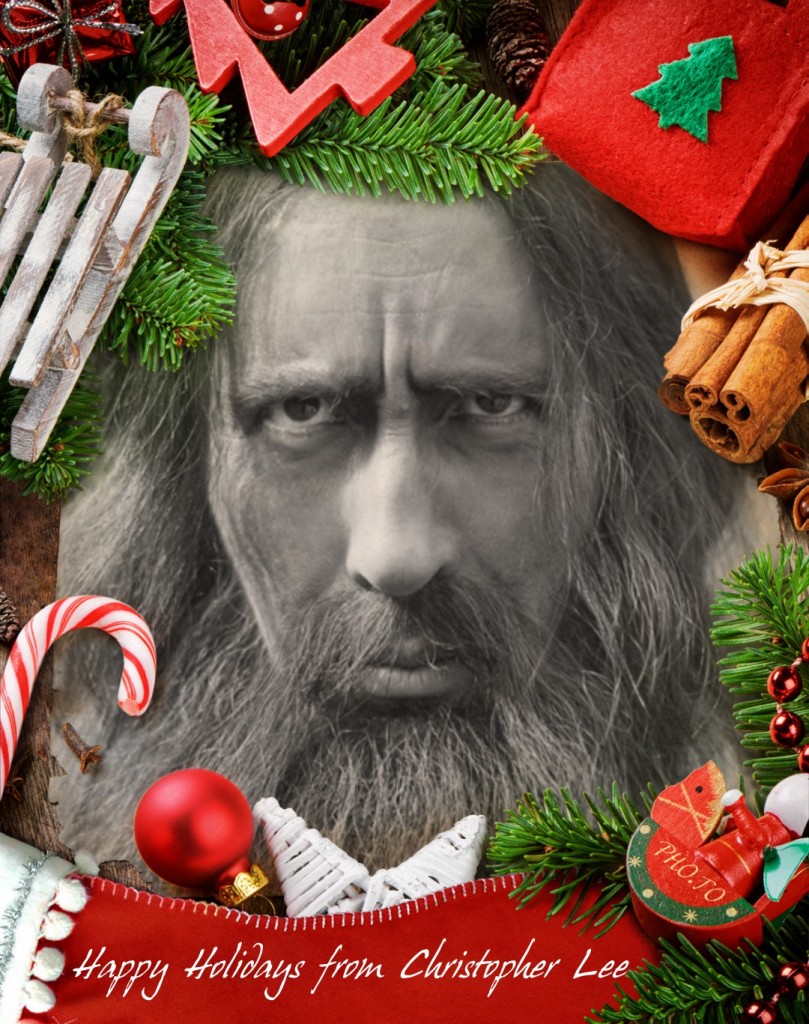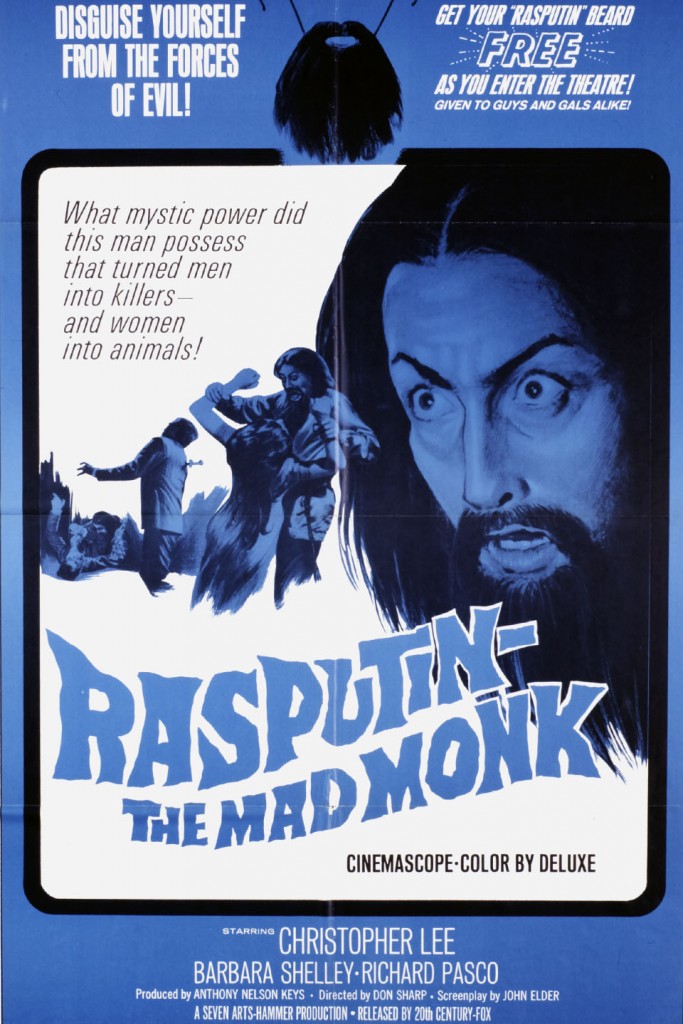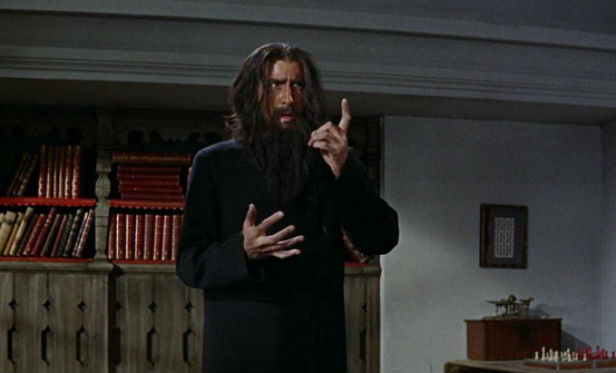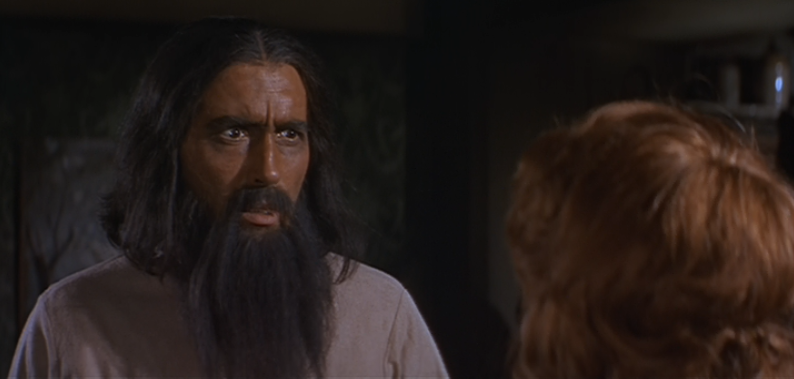Hammer Films for Your Holiday Joy: Rasputin the Mad Monk
 When October disappears over the horizon, horror movie DVDs and Blu-rays go into hiding, and streaming services store their terror title watchlists away for another day. But a certain type of off-kilter movie survives through the end of the year. The winter holidays usher in bizarre “ironic” seasonal favorites. You’ll probably watch Die Hard. Me, I’m a fan of Batman Returns when it comes to dark festive cheer. And Gremlins. We can add The Krampus to the list of holiday-themed horror flicks. Your family may insist on National Lampoon’s Christmas Vacation, although if you’re of my mind you’d prefer your cartoony Christmas violence via Home Alone. Or In Bruges. The Lord of the Rings films have a certain holiday vibe, and the same goes for the Harry Potter saga. If you want to take in a Bond movie for the Yuletide, there’s On Her Majesty’s Secret Service … although you may wish to shut it off two minutes before the end.
When October disappears over the horizon, horror movie DVDs and Blu-rays go into hiding, and streaming services store their terror title watchlists away for another day. But a certain type of off-kilter movie survives through the end of the year. The winter holidays usher in bizarre “ironic” seasonal favorites. You’ll probably watch Die Hard. Me, I’m a fan of Batman Returns when it comes to dark festive cheer. And Gremlins. We can add The Krampus to the list of holiday-themed horror flicks. Your family may insist on National Lampoon’s Christmas Vacation, although if you’re of my mind you’d prefer your cartoony Christmas violence via Home Alone. Or In Bruges. The Lord of the Rings films have a certain holiday vibe, and the same goes for the Harry Potter saga. If you want to take in a Bond movie for the Yuletide, there’s On Her Majesty’s Secret Service … although you may wish to shut it off two minutes before the end.
But is there a place for Britain’s legendary Hammer Film Productions during Winter Solstice? After the 31st of October, do the Hammer DVDs and Blu-rays need to stay put by the Demon Elf on the Shelf?
No, I say! Hammer has a seasonal holiday treat, Rasputin the Mad Monk (1966). Okay, maybe only I consider it a holiday watch, but I’d like to share it with you.
Rasputin the Mad Monk is not a horror film. I have to make this clear upfront. Although released in many territories on a double bill with The Reptile and later paired with The Devil Rides Out on its first DVD release, Rasputin the Mad Monk is a historical melodrama with violent flourishes. Because the Hammer name is so synonymous today with “horror,” we forget that Hammer Film Productions was a busy studio that also put out comedies, science fiction, crime dramas, psychological thrillers, historical costume pictures, and adventure movies. Their reputation for horror ended up affecting the marketing of some non-horror fare: The Hounds of the Baskervilles (1959), a straight Sherlock Holmes adaptation, was sold with a drooling spectral wolfshead on the posters. Captain Clegg (1962), a swashbuckler about smugglers, was rechristened Night Creatures in the U.S. for no reason except that the distributor had that title lying around and wanted an excuse to use it.
But Rasputin does make a comfortable fit with the horror films that Hammer produced at its height. It has Hammer icon Christopher Lee at his most darkly charismatic. The production design of the film from Bernard Robinson is also vintage Hammer Gothic. There are a few touches of the horrific scattered through it, such as a gruesome acid disfiguration and a plow blade chopping off a hand. It’s not one of Hammer’s finest movies of the 1960s, but Rasputin the Mad Monk has enough energy to sustain ninety minutes of entertainment, and anyone who loves Christopher Lee will savor it.

I’m going to ignore issues of historical accuracy because Hammer basically gave me permission to. They released this disclaimer along with the movie: “This is an entertainment, not a documentary. No attempt has been made at historical accuracy.” The studio took this step partially to avoid legal action from one of Rasputin’s assassins who was still living at the time, Felix Yusupov (substituted in the film for a character named Ivan played by Francis Matthews). But it’s also a signal that this is an “anything goes as long as it fits the budget” approach to the story. Hearsay and legends have always shrouded Rasputin’s history, and the film is glad to embrace that ambiguity.
The story presented is a stripped-to-the-bone drama that follows Rasputin from his rustic life, where he parties violently and sometimes exercises a strange power to heal through his hands, to St. Petersburg, where he burrows his way into the Tsar’s family when he heals Prince Alexei after an accident. (An accident that Rasputin secretly helped arrange.) Rasputin works his magnetism to seduce women and continue his debauchery at the same time as he climbs politically. He terrifies and enrages a few fringe characters at the court, so they conspire to murder him. He takes a long time to die.
Rasputin spends much of the movie fomenting two abusive relationships to elevate himself. First there’s a ruined doctor, Boris Zargo (Richard Pasco), whom Rasputin humiliates in a drinking contest soon after his arrival in St. Petersburg. Rasputin then seizes Zargo’s ramshackle apartment as his base of operations and uses the weak-willed man until Zargo rebels and becomes a key conspirator.
The other relationship is more tragic: Sonia (Barbara Shelley), a handmaiden to the Tsarina, whom Rasputin hypnotizes, seduces, and horribly traduces as a tool to dig into the Russian royal family — and possibly as a way to seduce her friend, Vanessa (Suzan Farmer). Rasputin does everything in his power to ruin Sonia for no reason except that he can. He succeeds at her destruction, which is the catalyst that pushes the movie into its final act.
Rasputin the Mad Monk was produced back-to-back with Hammer’s first Dracula film in six years, Dracula: Prince of Darkness. The two films share much of the same lead cast (Lee, Shelley, Farmer, Matthews) and sets. The palace exterior beside the river in St. Petersburg is also the exterior of Dracula’s castle, and the frozen river is the death location of Lee’s characters in both films. The town tavern is also the same. Barbara Shelley even wears the identical coat across movies.
But although Dracula: Prince of Darkness had the larger budget and the better-known Hammer director, Terence Fisher, Rasputin ended up the superior film. Director Don Sharp, who helmed Hammer’s Kiss of the Vampire (1963), channels Fisher’s florid filming style so well in Rasputin that you might imagine Fisher had also directed it. Fisher needed to bring that energy to his Dracula film … and he didn’t. Rasputin’s prolonged murder scene, which takes five minutes of gagging, convulsing, stabbing, clutching, and falling, feels exactly like a Terence Fisher finale — although this mania is inherent in the source material.
 Richard Pasco and Barbara Shelley give fine tragic performances. Pasco, later a member of the Royal Shakespeare Company, has the most developed arc in the film as Dr. Zargo, who tries to claw up from his disgraceful failure as a doctor and the abyss of alcoholism to make a sacrifice as an instigator of the assassination plot. Shelley, a Hammer regular who always brought passion to sometimes underwritten parts, gets a juicy role as Rasputin’s primary victim. Her hysteria when the false holy man cruelly casts her aside is one of the movie’s most biting moments.
Richard Pasco and Barbara Shelley give fine tragic performances. Pasco, later a member of the Royal Shakespeare Company, has the most developed arc in the film as Dr. Zargo, who tries to claw up from his disgraceful failure as a doctor and the abyss of alcoholism to make a sacrifice as an instigator of the assassination plot. Shelley, a Hammer regular who always brought passion to sometimes underwritten parts, gets a juicy role as Rasputin’s primary victim. Her hysteria when the false holy man cruelly casts her aside is one of the movie’s most biting moments.
But this is Christopher Lee’s show from start to finish. Lee uses his actor’s intelligence and extensive knowledge of Rasputin’s life (which you can hear on display in his DVD commentary track) to craft a fierce performance. Few actors are better suited for a figure of such sinister magnetism and towering presence as Christopher Lee, and he rips into it. Just his physicality with his body and twisted hands is enthralling to watch. He puts away massive volumes of wine and dances vigorously at parties, which aren’t the spectacles that you usually see in a Christopher Lee performance, but that makes them even more welcome.
For Rasputin to work at all as a character, the audience must believe that this bizarre man has a mental vice grip on his victims — and Lee sells that with the demonic potency you’d expect. There’s a small moment in particular that stands out in how Lee makes Rasputin a man of mental rapacity: after he’s seduced Sonia and is lying bed with her, she mentions her friend Vanessa, to which Rasputin responds, “Ah yes. The pretty one.” Lee makes this as venomous as possible.
Lee tears through the bombastic speeches as well, such as an early one where Rasputin rebukes an abbot for daring to criticize his aggressively sinful ways:
During the time that I’ve been here, you’ve tried to teach me that confession of my sins is good for the soul. You also removed all temptation from among us so there’s no chance of any sin here. I merely tried to put that right. When I go to confession I don’t offer God small sins, petty squabbles, jealousies. I offer him sins worth forgiving.
It’s good that Christopher Lee is invested in making Rasputin an epic figure, because the movie struggles mightily with a crimped budget that can’t get within a country mile of “epic.” It never feels as if the fate of an empire — one embroiled in a world war — is on the line, only a feud among a few well-dressed people. The small number of sets, the absence of any elaborate court sequences, and no appearance from the Tsar himself makes St. Petersburg seem as if it has only about a dozen people in it. At times, Rasputin feels like it might have been adapted from a stage play. The only big flourishes come courtesy of stock footage swiped from the 1956 Ingrid Bergman film Anastasia.
 I can’t speak as an expert on Russian period clothing, but it seems that there’s a particularly, well… Germanic quality to most of the peasant outfits. Perhaps it was what Hammer had in the costume department, just as they only had Transylvanian sets available. It makes me wonder what the studio would’ve done with an adaption of War and Peace on a budget. Maybe they would’ve made Napoleon a vampire and cast Peter Cushing as Pierre to stake him. I’d definitely watch that. Perhaps cast Christopher Lee as a meta-intrusion of Leo Tolstoy into the story. Lee would’ve made a great Tolstoy.
I can’t speak as an expert on Russian period clothing, but it seems that there’s a particularly, well… Germanic quality to most of the peasant outfits. Perhaps it was what Hammer had in the costume department, just as they only had Transylvanian sets available. It makes me wonder what the studio would’ve done with an adaption of War and Peace on a budget. Maybe they would’ve made Napoleon a vampire and cast Peter Cushing as Pierre to stake him. I’d definitely watch that. Perhaps cast Christopher Lee as a meta-intrusion of Leo Tolstoy into the story. Lee would’ve made a great Tolstoy.
I’ve delayed this point, so you may be thinking, “Why is this a movie appropriate for the winter holidays?” What makes seasonal viewing for one person isn’t the same as for another, but here’s my list of winter holiday cheer Rasputin the Mad Monk offers: drinking, dancing, sweet red wine (lots and lots of it), snow, and Imperial Russia, which brings with it a Tchaikovsky-touch without having to watch yet another version of the Nutcracker. (Although if you want a pure holiday nightmare, tread cautiously to Nutcracker in 3D, a 2009 movie that twists the classic story into a rat-ruled dystopia filled with Nazi iconography. You have been warned.)
Unfortunately for North American viewers, Rasputin the Mad Monk isn’t easy to get hold of today. The two Anchor Bay DVD releases, one which includes The Devil Rides Out, are long out of production and cost over $30 used. U.K. viewers are more fortunate, as they always are when it comes to Hammer movies, with an easily available Blu-ray. We can only hope for some state-side streaming options one day.
There are more elaborate and expensive movie treatments of Rasputin’s legend if you’re searching for that. For sheerest fantasy, there’s the animated Anastasia, with Christopher Lloyd voicing a zombie Rasputin — something I’d love to see in live-action. You can go for historical spectacle with the HBO television film Rasputin: Dark Servant of Destiny with Alan Rickman (yeah!). But there’s only one Rasputin film from Hammer and only one that stars Christopher Lee, so there you go.
Happy Holidays, and please don’t eat the poisoned chocolates.
Ryan Harvey is one of the original bloggers for Black Gate, starting in 2008. He received the Writers of the Future Award for his short story “An Acolyte of Black Spires,” and his stories “The Sorrowless Thief” and “Stand at Dubun-Geb” are available in Black Gate online fiction. A further Ahn-Tarqa adventure, “Farewell to Tyrn”, is currently available as an e-book. Ryan lives in Costa Mesa, California where he works as a professional writer for a marketing company. Occasionally, people ask him to talk about Godzilla on interviews.
Sounds like a perfectly good holiday movie to me, but then I always think of The Godfather as a Christmas movie, because it’s during the season of joy and giving that Victor Sollozo and the Tattaglias garrotte Luca Brasi and make their hit on Don Vito. It’s as heartwarming as anything on the Hallmark Channel. (And I’ve always suspected that the Corleones were modeled on the Crosbys.)